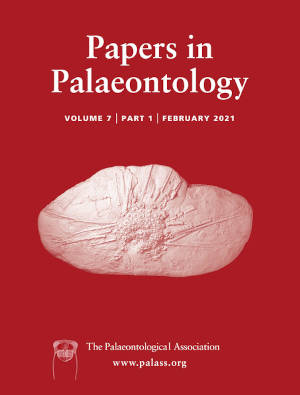Reg. Charity No. 1168330

The ‘acanthodian’ fishes provide key anatomical insights into the deepest branches of the chondrichthyan stem group. We review the anatomy of the acanthodian Vernicomacanthus uncinatus from the Lochkovian (Lower Devonian, 419.2–410.8 Ma) of Scotland based on eight articulated fossils, one of which is newly described. Broadly, the anatomy of V. uncinatus fits with that of contemporaneous acanthodians such as Climatius and Parexus, with a head covered by robust tesserae, an enlarged postorbital scale, an armoured shoulder girdle, and many pairs of ventrolateral spines. However, it departs from this anatomy in key respects. Its pectoral fin spines are obliquely ridged and posteriorly denticulated, similarly to Carboniferous gyracanth stem-group chondrichthyans. Its scales consist of multiple anteroposteriorly aligned odontodes, similarly to many Palaeozoic ‘sharks’. And its endoskeletal shoulder girdle may have a posterolateral angle, previously observed only in shark-like chondrichthyans. We propose that the differences between V. uncinatus and its congeneric, V. waynensis, which include potentially phylogenetically significant characters of the shoulder girdle and spines, are sufficient to erect a new genus for V. waynensis: Dobunnacanthus gen. nov. The scales of Vernicomacanthus are identical to those of the ‘shark’ scale genus Altholepis, suggesting that some such scales may instead belong to taxa with acanthodian-like gross anatomies. Based on these scales we highlight potential patterns in chondrichthyan scale evolution, in particular the axial addition of odontodes. Anatomical similarities between Vernicomacanthus and gyracanths, highlighted by previous authors, may indicate the existence of a grade including these and similar acanthodian-grade taxa placed relatively crownwards in the chondrichthyan stem-group.
AcknowledgementsWe are very grateful to the museum curators who helped with access to material used in this study, particularly Stig Walsh at the National Museums of Scotland, Edinburgh, who kindly loaned a number of specimens and allowed us to prepare them, but also to Emma Bernard at the Natural History Museum, London, David Lampard, at the McManus Museum, Dundee, and John Johnstone, at Montrose Museum, Montrose. Many thanks also to Tom Davies at the University of Bristol, who helped with CT scanning, to Anna Jerve, for help acid-preparing NMS G.2001.7.4, to Tomasz Goral at the Natural History Museum, London, for help with SEM, and to Plamen Andreev and Lisa Schnetz, for useful discussion. We are thankful to Mike Coates and an anonymous reviewer, whose comments improved the manuscript. This work was funded by a European Research Council grant awarded to MDB under the European Union's Seventh Framework Programme (FP/2007-2013)/ERC Grant Agreement number 311092. RPD is supported by the Paris Île-de-France Region, DIM ‘Matériaux anciens et patrimoniaux’- DIM PHARE projet.